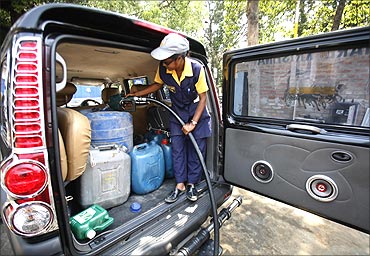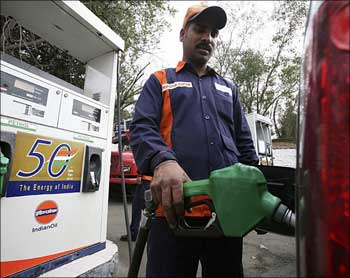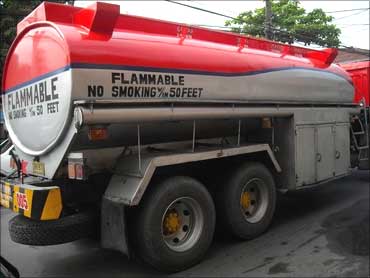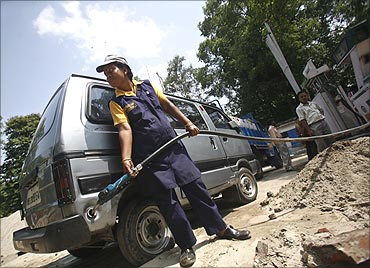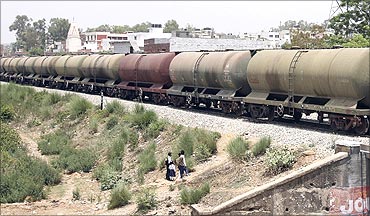 | « Back to article | Print this article |
Why PetroMin remedy may not beat the oil mafia
The petroleum minister's three-pronged approach does little to address the real issues of fuel diversion and adulteration, say experts.
For a litre of kerosene mixed with diesel in 2005, an adulterator earned a Rs 19.43 margin. With this incentive, a little more than 38 per cent of subsidised kerosene was then being diverted for purposes other than the public distribution system.
Almost six years after the National Council for Applied Economic Research estimated that figure to the diversion of PDS kerosene, the margin earned through such illegal means has jumped almost 30 per cent to Rs 25.18, with kerosene currently priced at Rs 12.32 a litre and diesel at Rs 37.75.
There are no fresh estimates available for the extent of diversion, even as oil marketing companies have brought down the amount of kerosene sold through the PDS every year by about 4 per cent as a result of higher LPG penetration. But it's easy to guess the diversion has risen manifold.
Though the pricing differential between the fuels lies at the root of adulteration and a thriving fuel mafia, Petroleum Minister S Jaipal Reddy has ruled out any cut in subsidy, calling it a "theory" with which he agrees, but something that is politically unfeasible.
Click NEXT to read on . . .
Why PetroMin remedy may not beat the oil mafia
"Whatever is politically not possible, for me it is not sensible," he said while addressing a packed media gathering on the recent killing of Additional Commissioner Yashwant Sonawane in Maharashtra when he intercepted adulteration activity.
What sounded as a consolation, though, was the announcement of a three-point agenda: Introduction of the marker system, GPS-based monitoring of kerosene trucks, and sharing of dispatch details between oil companies and the state food & civil supply department -- aimed at tackling the problem of adulteration -- with the help of state governments.
Experts, who have been pushing the Centre to price fuels at market rates and target subsidies more efficiently through direct disbursement of cash or coupons to the poor, say Reddy's remedy does not make much sense.
"If it is not politically feasible to change the pricing system, is it feasible to save bureaucrats from being killed while going on anti-adulteration drives? For how long are we going to hide behind political infeasibility as the reason for such distortions?" questions Leena Srivastava, executive director, The Energy & Resources Institute (better known as Teri).
Click NEXT to read on . . .
Why PetroMin remedy may not beat the oil mafia
Srivastava dismisses the marker system as being a failure. "All this has been tried. Subsidy should go to the end user in cash so that the mechanism does not have work down the entire value chain," she says.
The government had in 2006 introduced a dye sourced from US firm Authentix in kerosene, but withdrew it in 2009 pending toxology tests.
The coupon system is another option for direct subsidy credit instead of a subsidised retail price. "Distribution should be streamlined by way of a coupon system, so that only the intended beneficiary can purchase subsidised kerosene at a shop by producing the coupon. This will reduce diversion," suggests Shashanka Bhide, senior fellow, NCAER.
The Kirit Parikh Committee report, which set the ground for decontrol of petrol prices, had last year also suggested a single price in the market that would be close to the price of diesel to eliminate any incentive to mix it with diesel.
Click NEXT to read on . . .
Why PetroMin remedy may not beat the oil mafia
"This can be achieved if PDS kerosene is provided to BPL (below poverty-line) households through a system of smart cards with biometric identification. The cards would indicate the household's entitlement of subsidised kerosene. This will reduce PDS kerosene needs by one third, as diversion would cease," stated the report.
Since the use of smart cards target the subsidy on kerosene might take two years or more until the unique identification project becomes fully operational, the report recommended that in the medium-term allocation across states should be rationalised to bring down all-India allocation by at least 20 per cent.
It said the price of PDS kerosene should be increased to at least Rs 15 a litre to keep subsidies at reasonable levels and to keep diversion and adulteration under check.
Thereafter, the price of PDS kerosene can be raised every year in step with the growth in per capita agricultural GDP at nominal prices.
Click NEXT to read on . . .
Why PetroMin remedy may not beat the oil mafia
Following the report, the price of kerosene was increased to Rs 12.32 a litre from Rs 9.09 in June 2010 -- the first major hike since 2002, when the was increased by Rs 1.60.
The ministry of petroleum & natural gas says monitoring PDS kerosene is the domain of state governments.
"A miniscule level of adulteration takes place at retail outlets (belonging to three government-owned companies Indian Oil, Bharat Petroleum and Hindustan Petroleum)," says petroleum secretary S Sundareshan.
According to government statistics, there were 59 cases of suspected adulteration and 78 cases of stock diversion in 2009-10 at these outlets.
Click NEXT to read on . . .
Why PetroMin remedy may not beat the oil mafia
The oil marketing companies, however, cannot shrug off responsibility since the marketing discipline guidelines provide that these companies conduct regular and surprise inspections at kerosene dealerships and take action against those indulging in diversion and black marketing of kerosene.
The ministry also does not have any estimate of the loss caused to the exchequer by the siphoning off of kerosene subsidy, although a back-of-the-envelope calculation reveals that at 38 per cent diversion (the figure in 2005), Rs 6,600 crore (Rs 66 billion) in kerosene subsidy did not go to the targeted population at 2009-10 price levels, while the figure was much higher at Rs 10,725 crore (Rs 107.25 billion) at 2008-09 levels.
Besides, a consequence of this diversion is that more than Rs 20,000 crore (Rs 200 billion) of investment in producing Euro-III and Euro-IV diesel is wasted to a large extent if diesel is adulterated by kerosene.
A lot of money, it seems, is being put into a black hole with no well-oiled machinery to tackle the basic issues of governance and prevention of malpractices.

